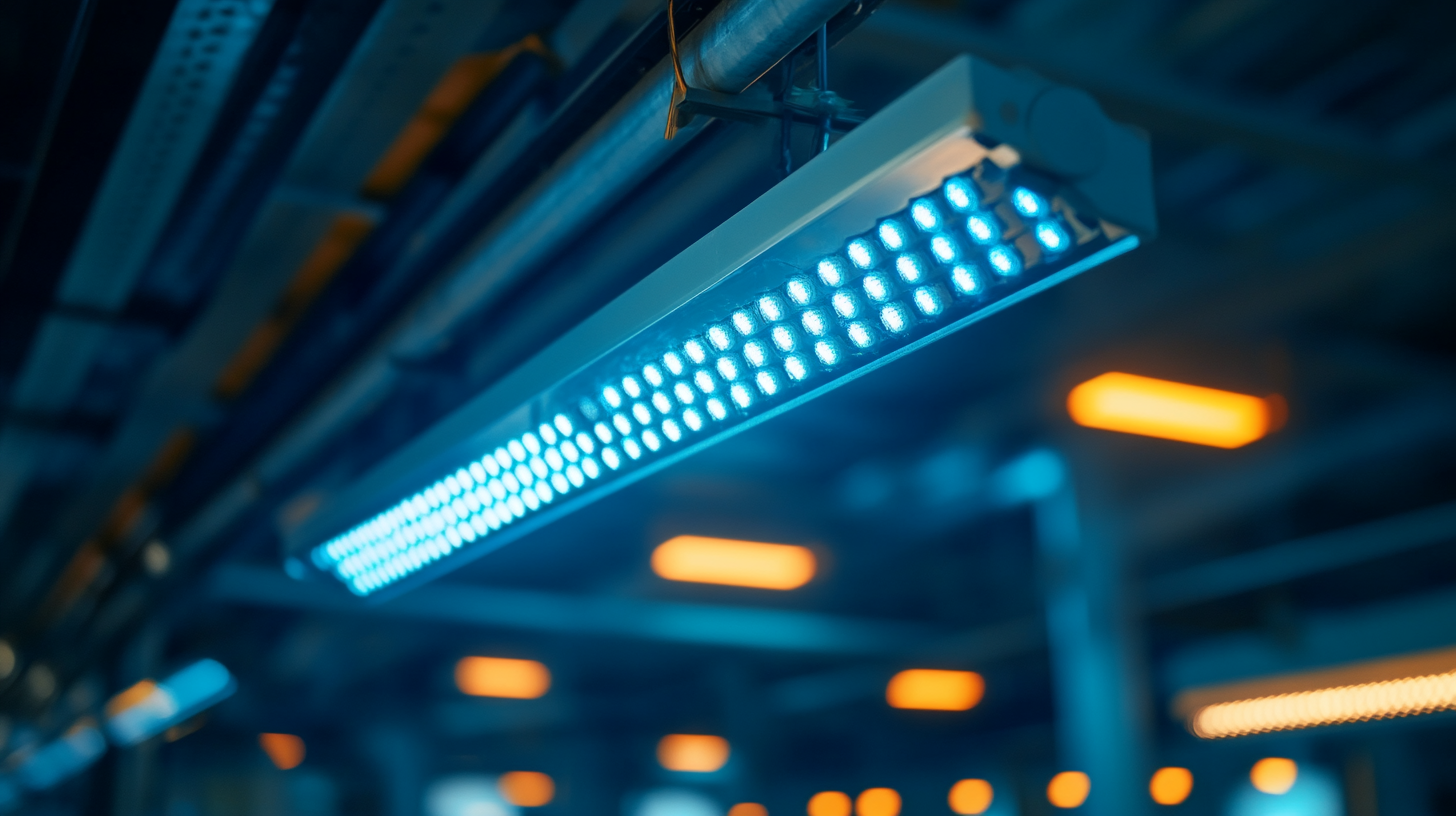Innovative Sensor Led Lights Transforming Energy Efficiency in Modern Manufacturing
The integration of Sensor LED Lights in modern manufacturing is revolutionizing energy efficiency and operational effectiveness. According to a report from the International Energy Agency (IEA), lighting accounts for approximately 19% of global electricity consumption, highlighting the urgent need for innovative solutions that can mitigate this energy drain. Leveraging advanced sensor technology, these LED lights not only optimize energy usage but also enhance productivity by adapting to real-time environmental conditions. Research indicates that incorporating sensor-enabled lighting systems can lead to energy savings of up to 50%, significantly reducing operational costs. As manufacturers increasingly prioritize sustainability and cost-efficiency, the adoption of Sensor LED Lights is emerging as a critical strategy in the quest for greener production practices. This blog will explore how these innovative lighting solutions are transforming the manufacturing landscape.

The Rise of LED Technology in Manufacturing Facilities
The rise of LED technology in manufacturing facilities represents a significant shift towards enhanced energy efficiency and sustainability. As companies worldwide invest in advanced technologies, the adoption of LED lights has emerged as a crucial component in the evolution of modern manufacturing processes. With their ability to consume less energy while providing superior lighting quality, LED systems are helping manufacturers reduce operational costs and minimize their carbon footprint.
Recent developments, particularly in China, illustrate the broader trend of innovation in manufacturing. As the country enhances its manufacturing capabilities, companies like Veira Group are pushing the envelope with new LED production facilities aimed at increasing output significantly. This not only reflects an industry-wide shift towards automation and smart manufacturing but also highlights the growing demand for energy-efficient technologies in production environments. Consequently, LED lighting is becoming integral to meeting the challenges posed by modern manufacturing while supporting sustainability goals.
As the industrial display market continues to expand, fueled by the adoption of Industry 4.0 technologies, the implementation of LED solutions will likely play a pivotal role in driving operational efficiency. By embracing innovative lighting technologies, manufacturing facilities can optimize their performance and stay competitive in a rapidly changing global market driven by digital transformation and renewable energy initiatives.
Key Advantages of Innovative Sensors in Lighting Systems
Innovative sensors in lighting systems are revolutionizing energy efficiency in modern manufacturing. By integrating advanced sensing technology, these systems can dynamically adjust lighting based on real-time conditions. From occupancy detection to ambient light sensing, these features ensure that energy is used only when necessary, significantly reducing waste. For instance, when a space is unoccupied, the sensors can automatically dim or turn off lights, leading to substantial energy savings and lower operational costs.
Another key advantage of incorporating innovative sensors in lighting systems is the enhanced flexibility they offer. Manufacturers can tailor lighting conditions to specific tasks or environments, optimizing visibility and productivity. These smart systems can also provide valuable data analytics, allowing businesses to track energy usage patterns and make informed decisions about future upgrades or changes in lighting strategies. As industries continue to prioritize sustainability and cost-effectiveness, sensor-led lighting systems are becoming essential components of energy-efficient manufacturing processes.
Innovative Sensor Led Lights Transforming Energy Efficiency in Modern Manufacturing - Key Advantages of Innovative Sensors in Lighting Systems
| Advantage | Description | Impact on Energy Efficiency |
|---|---|---|
| Real-time Monitoring | Sensors provide continuous data on lighting usage and efficiency. | Allows for immediate adjustments, reducing energy waste. |
| Adaptive Lighting | Lighting adjusts automatically based on occupancy and daylight. | Significantly lowers energy consumption during off-peak hours. |
| Integration with Smart Systems | Supports connection with IoT devices for enhanced control. | Improves overall energy management and operational efficiency. |
| Longer Lifespan | LEDs last significantly longer than traditional lighting options. | Reduces replacement frequency, lowering long-term maintenance costs. |
| Environmental Sustainability | Reduced carbon footprint and less hazardous waste. | Promotes greener manufacturing practices. |
How Sensor-Driven Lighting Enhances Energy Efficiency
In recent years, the integration of sensor-driven lighting systems in modern manufacturing has revolutionized energy efficiency. According to a report by the U.S. Department of Energy, lighting accounts for nearly 20% of total energy use in manufacturing facilities. However, with the adoption of innovative sensor LED lights, companies are witnessing a significant reduction in energy consumption. These systems adjust brightness based on occupancy and natural light levels, ensuring that energy is not wasted when spaces are unoccupied.
Moreover, a study published by McKinsey & Company highlights that manufacturing plants can achieve up to 50% energy savings by implementing smart lighting solutions. These advancements not only reduce operational costs but also contribute to sustainability goals by lowering carbon emissions. As manufacturers increasingly prioritize energy efficiency, the role of sensor-driven lighting technologies stands out as a key element in driving operational improvement and fostering a greener industrial landscape.
By optimizing lighting in real-time, manufacturers can enhance not only energy efficiency but also worker productivity. A well-lit environment positively impacts employee morale and performance, indicating that the benefits of sensor-led lights extend beyond energy savings to creating safer and more efficient workplaces.

Case Studies: Successful Implementations of LED Sensor Lights
The energy efficiency revolution in modern manufacturing is being significantly propelled by the adoption of innovative LED sensor lighting solutions. Case studies across various industries highlight how these technologies have transformed operational dynamics. For instance, Travelodge's implementation of LED sensor lights resulted in substantial energy savings, contributing to a remarkable reduction of £3 million in energy costs. This case exemplifies the efficacy of data-driven energy management approaches that not only reduce operational expenses but also lower carbon emissions, showcasing how hotels can operate sustainably while enhancing guest experiences.
Furthermore, integrating intelligent environmental controls in manufacturing plants has demonstrated the importance of sensor technologies in optimizing energy use. Research has shown that adaptive lighting systems can adjust based on occupancy and natural light conditions, resulting in energy consumption reductions of up to 30%. Such systems, when combined with automation and artificial intelligence, can provide manufacturers with real-time data analytics, enabling better decision-making and resource allocation. As industries seek to enhance sustainability practices, the transition to LED sensor lighting emerges not just as a trend, but as a pivotal strategy for improving energy efficiency and promoting sustainable operations.

Future Trends: The Next Generation of Smart Lighting Solutions
The emergence of innovative sensor-led lighting solutions marks a pivotal evolution in energy efficiency within modern manufacturing. As industries increasingly pivot towards sustainability, the integration of smart lighting technologies has become paramount. According to a recent report by MarketsandMarkets, the smart lighting market is projected to reach $83 billion by 2025, with a significant portion driven by advancements in sensor technologies that optimize energy consumption and reduce operational costs.
As we look ahead to the future trends in smart lighting, the upcoming Bluetooth Asia 2025 conference in Shenzhen will spotlight the transformative power of wireless technologies. The event will showcase how advancements in Bluetooth connectivity enhance the functionality of smart lighting systems, allowing for improved control and automation. Notably, smart lighting solutions can reduce energy usage by over 70% in commercial settings, highlighting their potential for widespread adoption.
Additionally, with the rise of IoT and smart manufacturing practices, the use of adaptive lighting that reacts to real-time changes in the environment is becoming increasingly viable. Research indicates that such systems not only improve energy efficiency but also enhance worker productivity. As industries embrace the next generation of lighting solutions, the convergence of innovative sensor technologies and wireless networking will undoubtedly reshape the operational landscape.
Energy Efficiency in Modern Manufacturing: Innovative Sensor Led Lights
This pie chart illustrates the distribution of energy savings achieved through the implementation of innovative sensor LED lights in modern manufacturing processes. The increasing adoption of smart lighting solutions significantly contributes to energy efficiency, showcasing the potential for further advancements in this field.
